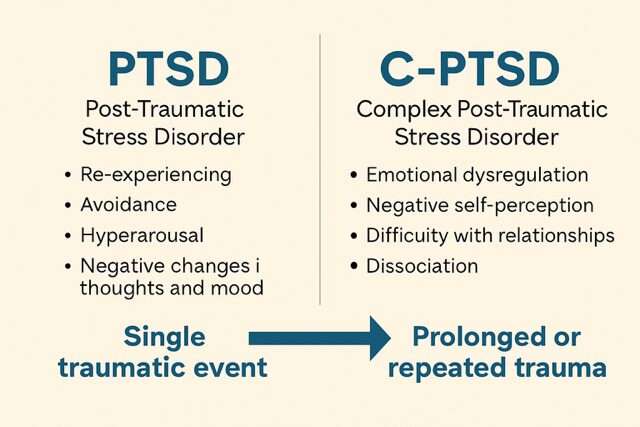When we hear the term PTSD (Post-Traumatic Stress Disorder), many of us think of combat veterans, survivors of natural disasters, or people who’ve endured single traumatic events. However, there is another related and often misunderstood condition called C-PTSD (Complex Post-Traumatic Stress Disorder). While both involve trauma and can deeply affect a person’s mental health, they stem from different types of trauma and manifest in distinct ways.
Here, I’ll break down the key differences between PTSD and C-PTSD, their symptoms, causes, and why distinguishing between them is important for proper treatment and support.
What is PTSD?
PTSD is a psychiatric disorder that can occur in people who have experienced or witnessed a traumatic event such as:
-
A serious accident
-
A natural disaster
-
A violent assault
-
Combat or war
-
A terrorist act
Common Symptoms of PTSD:
-
Re-experiencing the trauma through flashbacks or nightmares
-
Avoidance of reminders of the trauma
-
Hyperarousal, such as being easily startled or feeling constantly on edge
-
Negative changes in thoughts and mood, including feelings of guilt, depression, or detachment
PTSD can develop shortly after the traumatic event or even months or years later.
What is C-PTSD?
C-PTSD stands for Complex Post-Traumatic Stress Disorder. It includes all the core symptoms of PTSD but arises from prolonged or repeated trauma, typically in situations where escape is difficult or impossible. These may include:
-
Ongoing childhood abuse (physical, emotional, or sexual)
-
Domestic violence
-
Human trafficking
-
Prolonged neglect or captivity
- Simply not having needs met throughout childhood
Additional Symptoms of C-PTSD:
In addition to the symptoms of PTSD, individuals with C-PTSD may also experience:
-
Emotional dysregulation – Difficulty controlling emotions, often leading to intense anger, sadness, or numbness.
-
Negative self-perception – Persistent feelings of guilt, shame, or worthlessness.
-
Difficulty with relationships – Trouble trusting others, feeling isolated, or repeatedly entering unhealthy relationships.
-
Dissociation – A sense of detachment from one’s body or surroundings, or memory gaps related to the trauma.
Key Differences Between PTSD and C-PTSD
| Aspect | PTSD | C-PTSD |
|---|---|---|
| Cause | Single traumatic event | Prolonged or repeated trauma |
| Trauma Duration | Short-term or one-time | Chronic, often over months or years |
| Core Symptoms | Flashbacks, avoidance, hyperarousal, mood changes | All PTSD symptoms plus emotional and relational difficulties |
| Self-Perception | May remain intact | Often severely damaged |
| Relationships | May be affected by trauma reminders | Often deeply impacted on a broader level |
| Common in | Accident survivors, combat veterans, disaster survivors | Survivors of child abuse, domestic violence, captivity |
Why the Distinction Matters
Misdiagnosing C-PTSD as PTSD can lead to incomplete treatment. C-PTSD often requires a more holistic approach that includes:
-
Long-term therapy focusing on rebuilding self-worth and relational safety
-
Skills for emotional regulation and grounding
-
Supportive environments that emphasise consistency and trust
Recognising C-PTSD as a distinct condition helps survivors feel validated in their experiences and opens the door to more tailored and effective care.
Final Thoughts
Both PTSD and C-PTSD are valid and serious mental health conditions that deserve compassion, understanding, and professional support. While they share similarities, recognising their differences is crucial for accurate diagnosis and treatment.
Ready to Begin Your Healing Journey?
If you’re struggling with the effects of trauma—whether from a single event or long-term experiences—you don’t have to face it alone.
Your story matters, and healing is possible.

